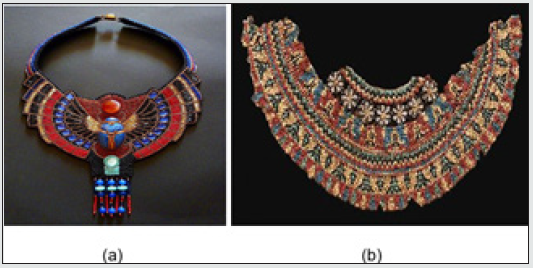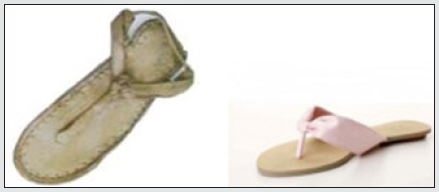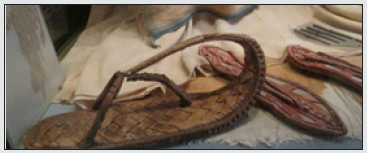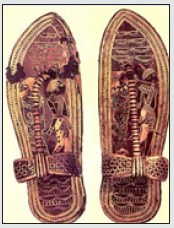
Lupine Publishers Group
Lupine Publishers
Menu
ISSN: 2690-5752
Review Article(ISSN: 2690-5752) 
Materiality and History of Archaeological Crafts in Ancient Egyptian and Using Them in Modern Fashion Design Volume 5 - Issue 5
Elsayed Elnashar1* and Adina Victoria Albu2
- 1Kaferelsheikh University, El-Geish Street, Egypt
- 2University of Oradea, Faculty of Energy Engineering and Industrial Management, Department of Textiles, Leather and Industrial Management, Romania
Received:October 04, 2021; Published: November 05, 2021
Corresponding author: Elsayed Elnashar, Kaferelsheikh University, El-Geish Street, 33516 Kaferelsheikh City, Egypt
DOI: 10.32474/JAAS.2021.05.000221
Abstract
The relations between historical studies and materiality oscillate from precariousness to rejection. The schism between them is ancient, deep-seated, and difficult to overcome. At human needs textile products , we are passionate about creating the world’s most comfortable woven textile products, but the secret comfort features we build into every pair will only work if your woven textile products fit correctly and work properly with your body. For Designer to provide a wealth of information about looking after these miracles of biological engineering, wander, stroll or saunter in the utmost comfort. In this article, basic definitions and elements of woven textile products, comfort and understanding comfort of textile materials, its relevance to braided for bodies choice and some assessment methods have been discussed.
Keywords: Archaeological Crafts; Ancient Egyptian Tapestry; Braided; Comfort Elements; Footwear
Introduction
Since its origins and due to a strongly entrenched vocation, historiography opted to privilege written sources of all types, granting material culture an illustrative role or a secondary place as corroboration of the contents of textual sources. It is worth adding that in reverse the situation is not much better, their technical or aesthetic characteristics.
Egyptian Tapestry
Is a form of textile art, its origin and origin go back to the Egyptian Paranoiac science 7000 years BC., traditionally woven by hand on a loom. Egyptian Tapestry is weft-faced weaving, in which all the warp threads are hidden in the completed work, unlike most woven textiles, where both the warp and the weft threads may be visible. In Egyptian Tapestry weaving, weft yarns are typically discontinuous; the artisan interlaces each colored weft back and forth in its own small pattern area. It is a plain weft-faced weave having weft threads of different colors worked over portions of the warp to form the design., Egyptian Tapestry is relatively fragile, and difficult to make, so most historical pieces are intended to hang vertically on a wall, or sometimes horizontally over a piece of furniture such as a table or bed. Some periods made smaller pieces, often long and narrow and used as borders for other textiles. Egyptian Tapestry tapestries are normally made to be seen only from one side, and often have a plain lining added on the back. Make tapestry to be seen from both sides. Most weavers use a natural warp thread, such as wool, linen or cotton. The weft threads are usually wool or cotton but may include silk, gold, silver, or other alternatives [1].
Egyptian braided footwear
is an essential human need with several functions, Egyptian Braided footwear in ancient Egypt was common, and although manufacturing techniques were fairly limited, the variation in forms is quite large. The present paper presents yet another category of fibre braided Sandals: coiled sewn braided Sandal s (Figure 1). As usual in studies of ancient Egyptian braided footwear, this paper focuses on the technological aspects and includes a description [2]. The choice of braided footwear is based on many factors such as personal desires, behavior consumers and the particular application; which are user dependent factors, people’s preferences may also be dynamic with fashion seasons, environment, age and type of activity in summer, to the wearer, comfort can be qualified as one approach to evaluate performance of Egyptian Braided footwear [3].
Figure 1: (I, II, III) Describing Braided Sandal of Ancient Egyptian. Three Egyptian Braided Sandals, made with closely connected manufacturing techniques. Scale bar in cm. [a] Dorsal surface of sewn braided Sandal, Ägyptisches Museum und Papyrussammlung Berlin ÄM 616. Photography by E. Endenburg, courtesy of Ägyptisches Museum und Papyrussammlung Berlin. [b] Dorsal surface of coiled braided Sandal, Petrie Museum UC 28308. Photograph copyright of the Petrie Museum of Egyptian Archaeology (UCL). [c] Dorsal surface of coiled sewn braided Sandal, Petrie Museum UC 28314iii. Inset: detail of the start of the coiling in the centre of the braided Sandal. Photograph copyright of the Petrie Museum of Egyptian Archaeology (UCL). [d] Construction drawing of the sewing technique in Egyptian Braided Sandal footwear [5].

Strap complex
Two different strap complexes can be identified. One is comparable to the type of straps seen in sewn Egyptian Braided Sandals (Veldmeijer, in press [a]; in press [b]) but not much is left; only the attachment of the back strap to the edge of the sole is left in two examples. The other type is best represented by the pair of Egyptian Braided Sandals in the British Museum (EA 4432, Figure 1a). The front strap is a broad strip of papyrus, which is inserted between the bundles at the front, and secured with a half knot. However, the ends of the papyrus back strap are still in situ, showing that these are inserted between the second and third bundle (seen from the outermost bundle), rather than being attached to the outermost coil (Figure 1a). Each one is secured at the ventral surface by means of an overhand knot (Figure 1a), inset of ventral view). [3]
Beads woven
made of row upon row of cylindrical beads, often with wristlets, anklets, and shoulder straps of matching design. Made and shoulder straps of matching design. However, artists who were representing their clients for eternity were not interested in the latest fashions and were usually reluctant to portray them. The rich tomb owner is never showing wearing bracelets like those of Djer, nor of Queen Hetep-heres, the wife of Sneferu and mother of the builder of the Great Pyramid; the queen`s bracelets. Of heavy gold hoops with an inlaid design of brightly colored butterflies. Amulets, furthermore, are scarcely ever shown, although they were the commonest type of jewelry and existed by the thousands. Of various shapes and materials, and each with its own specific role, they were usually tired around the finger, wrist, or neck by a piece of string; the esteem in which they were held by their owners is reflected in a story that has come down to us from the age of the pyramids. [4,5]
Egyptian beads definitions
Is a form punctured by a hole or holes can be organized through it, and is composed of multiple ores, whether natural ore such as some fruits, plant seeds, deposit, shells, wood, ivory, glass and pottery, plastic, wood, ivory, pearl and also beads are made of metals such as gold Silver and copper or of industrial and natural materials together as gilded beads is considered the first glass base in the ore beads [5].
Design Analyses
Design analyses of Braided Sandals Production and wear the production of coiled sewn braided Sandals consists of various stages. First, the material was collected and prepared, for which according is referred to work on ancient Egyptian basketry, gives much attention to this topic.
The Metatarso-Phalangiene Joints
Design analyses of A sketch of the foot is created by making a footprint of the planting top view (XY plan). This will provide a sketch of the foot, including the entire surface, the lateral and medial malleoles, as well as the ankle. The points required for the next steps are shown in Figure 2 [1] so that these features should be used when creating the contour for the barefoot print.
Design analyses of the planes forming the leg network share this network at different distances, one of the planes being located below the lateral and medial males, with priority being to find the plant fingerprint. The contour is located on the XY plane so that there is a possibility of having a top view of the foot (XY plane) requiring this view to select the outline for the center of the metatarso-phalangian joint of fingers 1 and 5. In this way, points were selected from the XY plane below the plane of the joints 1 and 5. These two points will be referred to as 6_xy and 7_xy. To find the position of points 6 and 7, the lines are drawn vertically by 6_xy and 7_xy and the points of intersection with the contour of the foot result. These intersections are points 6 and 7.
Ancient egypt footwear
Modern man tends to consider whether not superior, at least completely different from the one who lived in antiquity. The truth is, however, that today‘s people are similar to the old ones, and one of the things we have in common is...footwear. Though this was not invented by the ancient Egyptians, and most representations show us barefoot, there was a type of footwear they wore on various occasions even before the third millennium, sandals. Their sole was made of woven papyrus or, rarely, leather [6], and was tied to the foot with a strap. Egyptian sandals resemble today [7] Figure 3.
Figure 3: Anatomical Foot Measurement Points [1]. 1. Extreme point of the foot, 2. The center of the heel, 3. The center of the external maleole, 4. The center of the inner male, 5. The bending point of the foot, 6. The center of the metatarso-falangiene joint I, 7. The center of the metatarso-phalangian joint V, 8. The foremost point of the finger V, 9. Extreme point of the leg.

In most Egyptian representations, they - whether they are laborers, scribes, kings or gods - appear barefoot, but archaeological finds show that in reality sandals were worn at all levels of society, Figure 4. Everyday people, travelers, soldiers, priests, pharaohs all wore them, especially during the Temple service, as well as in later life at the Judgment of Osiris. They were so important that they were part of the pay of workers, along with other indispensable goods, such as wheat, barley, cloth. Besides the practical, sometimes aesthetic role, sandals also played a social role: a person with a lower social status had to be dissuaded in the presence of one with a superior social position. Moreover, from the first dynasty, there is also the prestigious function of the „Carrier of the Pharaoh‘s Sandals“ [5].
Given the importance of sandals, it is obvious that there is a hieroglyph (a symbol) through which they were represented, and pronounced tjebut (singular), tjebuti (plural). It was even suggested that the hieroglyph for „life“, ankh, would actually be a sandal strap, probably due to the identical or similar pronunciation of the two words („life“ and „strap“). The statuettes in Tutankhamun‘s tomb show us wearing gold sandals. The pharaoh‘s sandals are made of wood and covered with a veneer of pearls, green leather and gold foil on a reed base Figures 5 & 6. The outside sole are covered with a white reed. The ankle straps are made of shell ornamented with a pattern drawn in gold foil. The inner soles are black and Asian captive figures, linked to lotus and papyrus stems [5].
Results and Discussions
Images in the ancient Near East had a fundamental role in society. They had an ontological attribution that did not distinguish them from reality (Bahrani 2014, 63). In this context, the Amarna Period, which produced such a distinctive iconography, could have promoted significant changes in relevant issues. Images at Amarna were endowed with a constructive power, and might have created relevant social understandings of political and religious views conceived and conveyed by the time of Akhenaten’s worldview was introduced. As modern western scholars, we are placed at a considerable distance in time and mentality from the Amarna Period, which would generate some problems when we attempt to analyse images produced at the time of Akhenaten. It is difficult for us to fully understand their potential to create.
Egyptian tapestry subjects and style
It is a feature of Egyptian tapestry weaving, in contrast to painting, that Egyptian tapestry weaving an area of the work containing only relatively plain areas of the composition, such as sky, natural view grass or water, still involves a relatively large amount of slow and skilled work. This, together with the client‘s expectation of an effect of overpowering magnificence, and the remoteness of the main Egyptian tapestry influence, led to southern, northern compositions remaining crammed with figures and other details long after classicizing trends in Egyptian tapestry Renaissance painting had reduced the crowding in paintings. An important challenge to the Egyptian tapestry southern, northern style was the arrival in outside, probably in commission of a grand set depicting. These were sent to Rome and used the latest monumental classicizing Egyptian tapestry style, which was also reaching the southern, northern through prints [8].
Egyptian beads subjects and style
The continuity and revival of the heritage and raise the level of artistic taste, and to be inherited from the artworks a source of innovation to produce works of art serving different areas, to become a community of traditional Egyptian arts beads distinctive that emphasizes self-belonging to the environment for fashion trends.
Beads methods techniques:
a) Style beads systems. ,
b) Multi-style systems Multi-style beads systems with wire.
c) Weave style beads,
d) Perhaps the easiest and simplest methods used is the first method, and fits more with computer embroidery machines, which is the systems of beads in a thread of nylon hinge thickness depending on the size of the hole of the beads, and through this technique can get innovative embroidery.
Egyptian the braided footwear subjects and style
There are three basic routs of classes have been broadly used to define braided footwear comfort, and include: psychological/ ergonomic, sensorial/tactile/physical and physiological [9]. Each aspect is important relative to context and preference. Also, each comfort aspect is influenced by a variety of attributes within the braided footwear wearer-environment setting [10].
Conclusions
Vision concerns the audience. The observer eye can also perceive various forms, as well as different ways to interact with an image. Not only does the viewer see an image, but also the image provokes on them some kind of feeling, memory or association. A further task would be determining to what extent we are able to access what past actors saw and how they behave in the light of what images provoked on them. These considerations aim to make us able to face a pictorial source knowing what to look for. However, it is necessary to keep in mind that these procedures are not fixed, as it impossible to propose a rigid methodology for analysing images. Throw the influence the comfort elements of ancient Egyptian braided footwear of fashion preferences, cultural and personal values/preferences influence consumers’ modes and styles of braided footwear.
References
- ElNashar E A (2000) Design of Database for Forecasting the Specification of Woven Fabric Design for Ladies Dresses. University of Helwan, Cairo, Egypt.
- ElNashar E A (2018) A Unified Fashion Technology in Trends of Textile Engineering Science 7000Bc in Egypt. Journal of Trends in Textile Engineering & Fashion Technology 2(1): 1-3.
- ElNashar E A (1995) Effect of warp-ends densities distributions on some esthetical and physical properties of multi- layers woven fabric. Faculty of applied arts, University of Helwan, Cairo, Egypt.
- ElNashar E A (2019) Design and Production of Beads Woven Fabric in Fashion Trends for Garments of Egyptian Origin. Journal of Textile Science & Fashion Technology 4(2): 1-3.
- Veldmeijer A (2009) Studies of ancient Egyptian footwear, Technological aspects, Part XVI: Additional pair of leather open shoes. Journal of the American Research Center in Egypt 45: 235-245.
- ElSayed A ElNashar, Zlatin Zlatev, Julieta ILieva (2016) Textile Patterns Based on Ancient Egyptian Ornaments. Applied Research in Technics Technologies and Education 4(2): 92-104.
- ElNashar E A, Zlatin Zlatev (2016) Ancient Egyptian Ornaments for The Contemporary Fashion. Innovation and entrepreneurship, ISSN 1314-9253 IV(3): 55-67.
- ElNashar E A (2017) Mathematical Modelling of Volume Porosity In Mesh Knitting For Fisheries Technology. 9th World Congress on Aquaculture & Fisheries, October 23-24, 2017, Dubai, UAE.
- ElNashar E A (2017) Design Comfort Insulation Abilities of Crinkles Clothes for Europe Environment, Ukrainian Scientific-Practical Internet-Conference of Young Scientists & Students on Resource-Saving Technologies of Light, Textile & Food Industry, which will take place on November 16-17, 2017, in Khmelnytskyi, Ukraine.
- ElNashar E A, Smirnov A (2015) Three-Dimensional of Crinkles Effects Using Multilayer Woven Fabrics Containing Spandex. 5th Smartex-2015 Egypt (World Textiles Conference), [Engineering-Applied Arts-Specific Sciences] November 23-25, 2015, Kaferelsheikh University, Egypt.

Top Editors
-

Mark E Smith
Bio chemistry
University of Texas Medical Branch, USA -

Lawrence A Presley
Department of Criminal Justice
Liberty University, USA -

Thomas W Miller
Department of Psychiatry
University of Kentucky, USA -

Gjumrakch Aliev
Department of Medicine
Gally International Biomedical Research & Consulting LLC, USA -

Christopher Bryant
Department of Urbanisation and Agricultural
Montreal university, USA -

Robert William Frare
Oral & Maxillofacial Pathology
New York University, USA -

Rudolph Modesto Navari
Gastroenterology and Hepatology
University of Alabama, UK -

Andrew Hague
Department of Medicine
Universities of Bradford, UK -

George Gregory Buttigieg
Maltese College of Obstetrics and Gynaecology, Europe -

Chen-Hsiung Yeh
Oncology
Circulogene Theranostics, England -
.png)
Emilio Bucio-Carrillo
Radiation Chemistry
National University of Mexico, USA -
.jpg)
Casey J Grenier
Analytical Chemistry
Wentworth Institute of Technology, USA -
Hany Atalah
Minimally Invasive Surgery
Mercer University school of Medicine, USA -

Abu-Hussein Muhamad
Pediatric Dentistry
University of Athens , Greece

The annual scholar awards from Lupine Publishers honor a selected number Read More...








